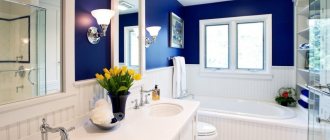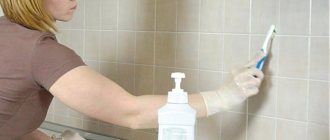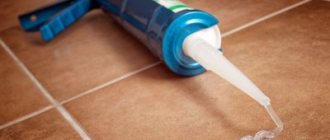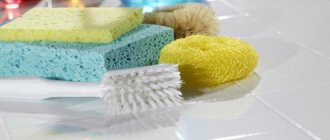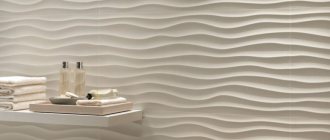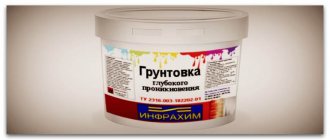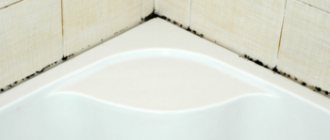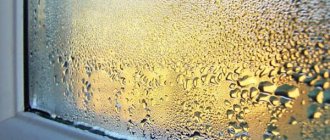Washing tiled walls and floors after renovation is a pressing problem for housewives. Many people don’t know how to make tiles shine and how to clean the seams between tiles on the floor.
But the desire for cleanliness forces us to look for ways to bring such surfaces into proper shape. It is especially important to know how to clean tiles quickly and without streaks. Often you have to put in a lot of effort to get the desired result.
Today there are many products for cleaning tiles; they can be purchased at a hardware store. But not only chemicals can help solve this problem; you can also use improvised means. Below are effective ways to properly wash ceramics using various compositions.
How to properly clean tile floors?
Wet the tile, apply a little baking soda to the sponge and gently wipe the tile. Also, if you care for your tiles regularly, then a glass and mirror cleaner will be suitable for you. With its help, you will quickly return the shine and bright color to your tiled floors. You can also use regular alcohol to clean tiled floors.
Interesting materials:
How to clean white faux fur on shoes? How to clean white faux fur at home? How to clean white faux fur? How to clean a white carpet at home? How to clean white carpet? How to clean a white leather sofa at home? How to clean a white leather sofa? How to clean a white matte case? How to clean white rabbit fur? How to clean white fur with semolina?
Preventive measures
To make it easier to clean bathroom tiles until they shine, you need to follow preventive measures. The main enemy of ceramics is condensation. It accumulates in the bathroom after using the room. It is necessary to ensure good ventilation in the bathroom and heating in winter. It is recommended to wipe the tiles after each bath and shower. In addition, try to avoid other contaminants left by hygiene products and powder.
Ceramic tiles in the bathroom must be washed with detergents at least 2-3 times a month. To maintain the shine of a glossy finish, it is recommended to use home remedies or special impregnations and varnishes.
In order not to spend a lot of time and effort on caring for tiles, it is better to take simple preventive measures.
Mold
To prevent mold and mildew from forming in the joints between the tiles, you need to periodically wipe them with a cloth soaked in vinegar. If the fungus has already settled on the grout, getting it out using non-mechanical means will be problematic: most likely, you will have to remove areas with mold and grout the seams again.
Advice
Although mold and mildew can be difficult to get rid of, they can be disguised using Whitewash. This method is ideal for white grout. If your flooring joints are a different color, test Whiteness on an inconspicuous area before using the product.
How to clean difficult stains from tiles?
Alcohol and vodka are ideal for stains. They rub the surface in pure form or after diluting it with a small amount of water. As in all other cases, after treatment you need to wipe the tiles with a dry cloth. It is worth noting that alcohol or vodka have a pungent odor. Therefore, after cleaning, you should thoroughly ventilate the premises.
Grease stains often appear in the kitchen, which are quite difficult to remove. Lemon juice will cope with the problem. It is recommended to squeeze it out of the fruit before harvesting so that it retains its beneficial properties. Rub the product thoroughly onto the contaminated surface and then rinse with water.
Rules of care
To avoid having to resort to drastic measures when cleaning floor tiles, adhere to the following care rules:
- Do not rub the stain with a hard brush or products that contain abrasives. They leave microscopic damage on the surface of the material, reducing the presentation and shelf life of the product.
- Don't put off starting cleaning for too long. Remember that the longer you wait, the more the stain eats into the tile.
Types of contaminants and removal methods
There are different types of dirt that form in the bathroom. There is a humid environment, constant temperature changes. As a result, soap scum, grease and other substances settle on the surface.
Mold on seams is dangerous and difficult to remove.
Household dirt
It is formed during the operation of the bathroom. You can remove traces of water splashes, soap suds, and drips using baking soda and warm water. Yellowed marks on tiles and seams are removed with laundry soap and ammonia. Rust is removed with a solution of soda and vinegar.
Construction dirt after renovation
After renovations in the bathroom, various products may remain on the tiles that cannot be removed with simple soap or vinegar. In such cases, you need to act differently.
- Glue solution. It is better to immediately remove it from the tiles before it has time to harden. If the moment was missed, then a rubber spatula and a weak solution of water and ammonia will come in handy. Moisten traces of glue, lightly rub with a rag or pry off with a rubber spatula. But the easiest way to remove it is with solvents. An acetone solution will help remove polymer glue from the surface. It is important not to rub too hard with sandpaper, a sponge or a spatula, so as not to damage the tile.
- Cement. For cement, the drug HG .
- Primer. Most often it is removed immediately upon application. If it’s later, it’s easy to clean the bathroom with alcohol.
- Grout. It's easier to wash it off while it's fresh. If it has time to harden, you will have to buy a special remover or rub the tile with acetone. Working simultaneously with a spatula and a damp rag, builders apply putty and remove the excess. Epoxy grout, when dry, is difficult to remove.
The grout must be removed immediately during repairs. - Sealant. It is recommended to remove it from the tiles before it has time to harden. In this form, it can simply be removed with a sponge or damp cloth. The hardened sealant can be cut off with a knife, and the remains can be removed with a scraper and solvent (for example, white spirit ). It can be purchased at a hardware store. If the sealant has switched to an acrylic bathtub, then it is better to use chemistry. Car wash does the job well.
- Dye. Don't scrape it off with a blade. It leaves scratches on the surface. Take a solvent to remove the dye.
How and with what to clean floor tiles and ceramic tiles from plaque in the bathroom and kitchen
Each of us strives to ensure that the bathroom at home always shines with cleanliness and brilliance. Of course, to achieve such a result you need to put in a lot of effort on a regular basis. But, you must admit, washing in a clean room is always pleasant and, what is also important, safe. You can be one hundred percent sure that you are not afraid of either fungus or mold if you take care of it yourself.
How to avoid the need to polish porcelain tiles?
Polishing after installing the tiles becomes necessary if violations of the operating rules occur. To reduce problems, try:
- Do not use strong chemicals when cleaning. Thanks to this, the shine of porcelain stoneware will be preserved for a longer period.
- In a timely manner, without delaying for a long time, remove any stains that have arisen.
- Try to avoid falling sharp objects, exposure to women's stiletto heels, and moving furniture across the floor. They are the cause of scuffs and cracks. Minimize these harmful effects.
Porcelain tiles can safely be considered unique materials. In addition to the fact that it belongs to the non-staining category, it is also easy to clean from dirt. But even a material with such unique properties needs proper care if you want it to last longer.
Table vinegar
To clean tiles use 6% vinegar. If this is not available, you can take 70% essence and combine it with water in a ratio of 1:11. The product has a negative effect on the skin and has a strong unpleasant odor. Therefore, before using the solution, you need to protect exposed skin, and after cleaning, ventilate the room.
Instructions for working with vinegar:
- Pour the solution into a spray bottle.
- Distribute evenly over the tiles, paying special attention to contaminated areas.
- Leave for a while and then clean with a soft brush.
- Wash the floor with clean and warm water, wipe dry with a microfiber cloth or other suitable fabric.
Vinegar effectively removes plaque and dirt, and destroys mold spores.
Alcohol
There are at least two ways to clean tiles using alcohol. In the first case, you need to dilute 125 ml of medical alcohol in 4 liters of water, treat the surface, and then wash the floor with clean water.
Second way:
- Dissolve 1 tbsp. l. ammonia in 2 liters of water and pour into a container with a spray bottle.
- Distribute the product over the tiles and wait 5 minutes.
- Remove any remaining ammonia with clean warm water.
Basic processing tips
If you want your tiles to shine, it is recommended that you clean them correctly. Experienced housewives and professional cleaning service employees have developed step-by-step instructions that will allow you to achieve the desired effect:
- Get rid of large amounts of dirt and debris. For example, if the bathroom or kitchen has been renovated, the premises have just been handed over to the developer, or the premises have not been thoroughly cleaned for a long time.
- Remove fine dust. To do this, use a dry cloth or mini vacuum cleaner. Dust brushes are not recommended - limescale deposits, as well as grease, are dangerous for this tool.
- Wash off dirt. For difficult stains, such as stubborn rust or old greasy deposits, select products individually.
- After the stains have been dealt with, rub the tiles with polish, soap or other composition until shiny.
In what cases is laid porcelain tile processed?
Rough grinding is carried out if a height difference between the seams of more than 5 mm is detected. This grinding evens out differences, removes unevenness and deep scratches. It is made with a grinder that has a planetary mechanism and is equipped with diamond discs with coarse grain size. The base of the grinding discs is metal.
Grinding and polishing followed by polishing is carried out if the height of the differences is less than 0.5 mm. In this case, medium scratches are removed by grinding, and finer ones by polishing. This treatment gives the surface gloss and shine. For these operations you also need a grinder with a planetary mechanism, using diamond discs of the required grit. These discs already have a plastic base.
The final operation is polishing the porcelain tiles using polishing powder. After it, the color of the stone becomes brighter and deeper, its shine intensifies, the reflection becomes clearer, and the service life increases.
If it is necessary to polish a porcelain stoneware floor, it begins after the surface has been cleaned and polished using coarse and fine-grained diamond pads.
Polishing after grinding is carried out with a grinding machine, only using diamond wheels with a very fine-grained base. At the same time, the surface of the porcelain stoneware is polished, acquiring a matte shine. For such material processing, high-speed rotary units are used.
Having completed the grinding using various attachments, the floor is cleaned of dust, followed by impregnation with a special compound that strengthens the porcelain stoneware. The strengthening process is called crystallization.
The final stage of final polishing is performed using polishing powders. Moreover, for each type of tile they use their own powders. Sometimes a glaze is applied to the surface of the tile, after which it is hardened. Thanks to this, the tile becomes less slippery, and the glaze caught in the roughness prevents dirt from accumulating.
To enhance the water resistance of the tile, its surface is treated with special sealing compounds, leaving until they are completely dry.
Cleaning process
Cleaning tiles under water pressure
Cleaning tiles on the floor is a relatively simple procedure, which nevertheless requires the implementation of certain rules and the use of special detergents. The cleaning process itself can be divided into several stages:
- Cleaning the surface of debris using a dry method using a vacuum cleaner or a simple broom;
- Preliminary wet cleaning, removing “light” dirt;
- Local cleaning of heavy soiling, which requires special means for washing tile floors, and the cleaning agent should not adversely affect both the surface and the grout;
- Final cleaning using preservative dirt-repellent agents, which, if necessary, add shine and additionally protect the surface from the effects of dirt.
Different types of ceramics used for flooring can have very different front surfaces, requiring different approaches to cleaning and the use of “their” detergents and cleaning agents.
Dirt
If your tiles are covered with makeup stains, soap scum, or real dirt, then you won’t need any special products or techniques to clean them: it will be enough to simply wipe the surface with a cloth or brush if the contamination is serious. A little effort and stains and stains will disappear even without the use of cleaning products! If desired, you can use a factory cleaner or regular soap, after which you need to rinse the tiles thoroughly.
Dirt can also be removed using soda, which acts as an abrasive component, and vinegar. Stir the ingredients to a paste consistency, apply to the dirt for 5 minutes, rub with a cloth and rinse with water to completely clean the tile of any remaining dirt.
Advice
Do not use metal sponges to clean tiles, even to remove old grease stains or residue, as they will scratch them. It is better to leave the product to stain for about 10 minutes, and then scrub it off with a brush.
Household chemicals
There are many products on store shelves designed to care for tiles. They come in different forms, but it is better to buy liquid or gel formulations. Powders effectively clean the surface, but contain abrasive particles that can damage the smooth surface and make it dull.
The advantage of household chemicals is that they are completely ready for use. However, it should be remembered that cleaning products contain many aggressive components that can negatively affect the health of humans and pets. Powders, particles of which enter the air and cause the development of allergic reactions, are especially dangerous.
Natural Ways to Add Shine to Tile Floors
Tile floors lose their shine over time due to dirt, stains and wear. Those dull floors can make the entire room look dated. Instead of ignoring dull floors, give them a new lease of life to restore them to their radiant glory. Commercial products can cost a lot of money, and it can be difficult to know which ones will best clean your floors. To save money and protect the environment from dangerous chemicals, use natural ingredients in your home to clean your floors and keep your tiles sparkling.
Natural Ways to Shine Tile Floors
Image Credit: Nathan Griffith/Corbis/GettyImages
Tile cleaner with vinegar
Vinegar is a tasty addition to many recipes, but it is also a powerful natural cleaner that is suitable for many different cleaning purposes. Mix 1 part water with 1 part white distilled vinegar in a 1 gallon bucket. Stir the solution to add the vinegar to the water. Using undiluted vinegar may damage the tile grout. The vinegar will disinfect and deodorize tile floors. Wash floors with diluted vinegar. Always squeeze out any excess liquid to prevent the tiles from becoming soaked. Alternatively, you can pour diluted vinegar into a spray bottle. Spray the floor in small areas and mop each area until the entire floor is clean.
Ammonia and water mixture
Mix 1/4 cup of ammonia with 1 gallon of warm water in a bucket. Soak a mop in the solution and squeeze out excess water. Mop the tile floor to disinfect it. If unusual yellow stains or mold appear on your tile floor, ammonia will restore the tiles to their original shine. Soak a sponge or nylon scrub pad in the solution and gently scrub the floor. Rinse off the ammonia solution with clean water and wipe the floor with a washcloth to remove any remaining residue.
Baking soda paste
Baking soda will remove tough tile and grout stains if the floor is looking dirty or discolored. Think of it as a natural tile varnish that helps rejuvenate the floor. Mix equal amount of baking soda with warm water to make a thick paste. Dip a soft-bristled toothbrush into the baking soda and scrub the grout and tiles. Let the baking soda sit for 10 minutes, then rinse the tiles with warm water. Repeat the process on the tile floor to remove obvious stains.
Vinegar, borax and ammonia
If your tile floors have accumulated tough soap scum or dirt, you can restore the shine by combining common household items to create a powerful cleaner. Mix 1/2 cup white vinegar with 1/2 cup ammonia and 1/4 cup borax. Add 1 gallon of warm water to the ingredients and stir lightly until well combined. Wipe the tile floor with the cleaning solution, then rinse the floor thoroughly. Allow the floor to air dry completely.
Sealant for glossy tiles
After you clean your tiles using natural materials, you can apply a high-gloss tile sealer for a little extra shine. The sealer also helps protect your tiles so they look great for longer. Choose a product that is suitable for your tile type. Most gloss sealers are designed for stone tiles that have a porous surface, not ceramic tiles. If you are using it on ceramic tile, test it on a sample tile or hidden area first to ensure it adheres well, as non-porous ceramic surfaces can cause problems. Keep in mind that topical sealers may become scratched or faded over time, so results may not be long-lasting. You can remove the sealant and reapply it.
Dull tiles will make the room drab. Using natural ingredients that you already have in the house, you can brighten up your tiles and give them a shiny and new look.
.
Why doesn't the tile shine?
Before you start scrubbing and polishing the tiles, find out the main reason for the loss of shine on the glossy surface. Since we are talking about a bathroom, there are several such factors.
Every day, walls are exposed to water, cosmetics, and soap. This affects both the state and external perception. Let us highlight several main reasons why tiles lose their original appearance:
- Limescale. During hygiene procedures, drops of water fall on the tiles. It is not perfectly pure and contains various minerals. When dry, whitish streaks remain on the wall, especially from hot water. The spots are traces of limescale. Without cleaning, over time the tiles will become covered with a rough, hard film.
- Soap. Almost every shower product contains a soap base. Getting on a glossy surface, it covers it with a cloudy white film. If you don't wash off the remaining foam, forget about shine.
- Cosmetics. Various products also cause cloudy plaque: creams, mousses, toothpaste, shaving gel. Small droplets fall on the tiles and spoil the appearance.
- Dirt. Various contaminants during house cleaning, washing household items, shoes, hands, laundry, etc. fall on the walls and floor. Multi-colored plaque covers the surface with spots, and causes the growth of bacteria and mold.
Bathroom tiles are susceptible to various types of stains and therefore require constant care.
If you decide to clean, do not use hard brushes, powders or aggressive solvents, as they damage the glossy surface and cause small scratches. In this case, you will achieve cleanliness, but forget about shine.
Effective repair of floor coverings.
New marble or granite floors have a beautiful high-gloss, reflective sheen that adds elegance and beauty. With use, these coatings tend to fade, lose their shine, and scratches and abrasions appear on marble and granite. This can be a problem, especially if you want the floor to be beautiful. Also, in addition to the poor appearance, problems begin with cleaning and washing such floor coverings, as they begin to get dirty very quickly. Therefore, special technologies are currently used, such as marble polishing, as well as floor polishing as a further step. Using little tricks, and in case of minor defects, you can restore the surface of marble and granite either on your own, or turn to specialists for this.
How and what to clean kitchen tiles from grease - commercial and folk remedies
Obviously, it is almost impossible to prevent grease from appearing on kitchen tiles. The oil we use in the frying process often splatters in all directions so that you can’t keep track of it. Inevitably, its drops fall on both household appliances and tiles. However, fat can be successfully combated.
Tip: Clean dirty surfaces with a sponge with a few drops of dishwashing detergent (Fairy, Frosch, Myth, etc.) every time after cooking. It has been proven that fresh stains are always much easier to remove than stubborn ones.
Today, a wide range of chemical compounds are offered that help deal with grease in the kitchen and restore tile shine. If you decide to purchase such a product, first of all pay attention to the instructions. Make sure the product can be used to clean tiles. Also be guided by a few rules:
- Do not use acidic chemical mixtures. The aggressive components in them can have a detrimental effect on the grout in the joints.
- To prevent scratching of tiles, give up powders and switch to gels, sprays and creamy formulations. Also use soft sponges and rags during the washing process.
- Do not use all-purpose cleaners on stainless steel surfaces. They not only remove grease, but also deprive the tiles of their shine.
